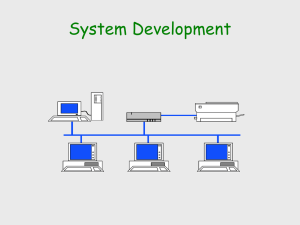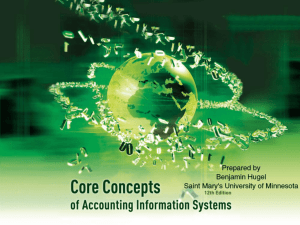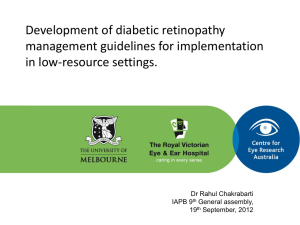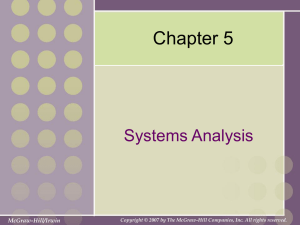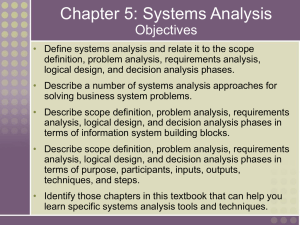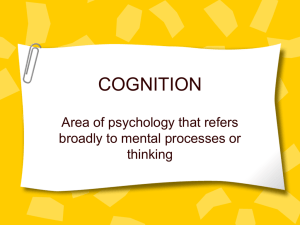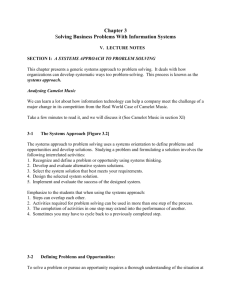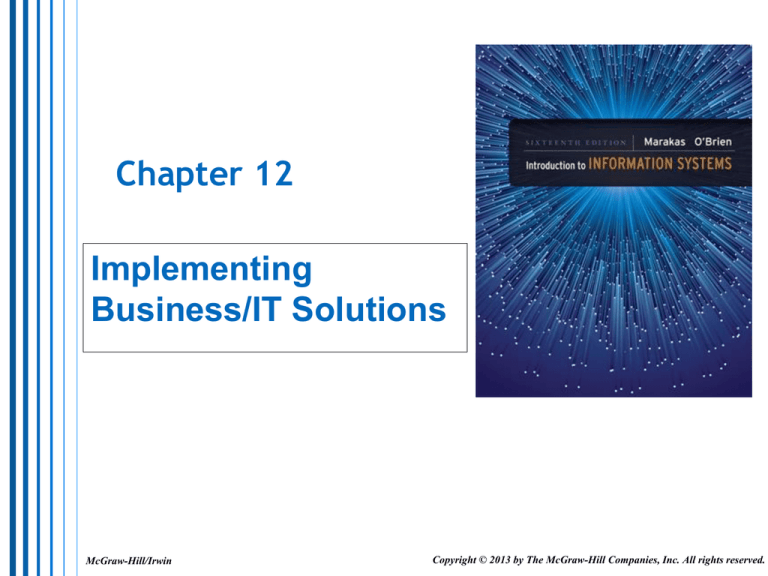
Chapter 12
Implementing
Business/IT Solutions
McGraw-Hill/Irwin
Copyright © 2013 by The McGraw-Hill Companies, Inc. All rights reserved.
Learning Objectives
Use the systems development process outlined
in this chapter and the model of IS
components from Chapter 1 as problem–
solving frameworks to help you propose
information systems solutions to simple
business problems.
Describe and give examples to illustrate how
you might use each of the steps of the
information systems development life cycle to
develop and implement a buiness information
system.
12-2
Learning Objectives
Explain how prototyping can be used as an
effective technique to improve the process of
systems development for end users and IS
specialists.
Understand the basics of project management
and its importance to a successful systems
development effort.
Identify the activities involved in the
implementation of new information systems.
12-3
Learning Objectives
Compare and Contrast the four basic
information system conversion strategies.
Describe several evaluation factors that should
be considered in evaluating the acquisition of
hardware, software, and IS services.
12-4
Section 1
Developing Business Systems
12-5
I. IS Development
• Applying the Systems Approach to IS development
• The Systems Approach is a systematic way to develop
a solution to a problem
12-6
II. The Systems Approach
Uses a systems orientation to defining and solving
problems and opportunities
Problem Solving – there are specific steps in solving
any problem
Recognize/Define a Problem or Opportunity – recognize it
exists
Develop and Evaluate Alternative System Solutions – what are
the different ways to solve this problem?
Select the Best System Solution – decide which alternative is
best
Design the Selected System Solution – design the system for
the chosen solution
Implement and Evaluate the Success of the Designed System
– put the solution into effect and monitor results for the
outcome
12-7
II. The Systems Approach
Systems Thinking – the “Fifth Discipline”
– seeing the system context
See the Interrelationships among the
systems rather than linear cause-and-effect
chains
See the Process of change among the
systems rather than discrete ‘snapshots’ of
change
12-8
II. The Systems Approach
Systems Thinking
12-9
III. Systems Analysis and Design
The process of designing and
implementing an IS – Object-oriented or
Life Cycle approaches
The Systems Development Life Cycle – a
multistep, iterative process to designing
systems, very popular, 5 Phases:
Investigation, Analysis, Design,
Implementation, Maintenance
12-10
IV. Starting the Systems Development
Process
Systems development can be very costly,
investigations are made to determine whether to
proceed
Feasibility Studies – identify needs, resources, costs,
benefits
Operational Feasibility – will the proposed system fit
existing business environment and objectives?
Technical Feasibility – degree to which current
technical resources can be applied to the new
system
Human Factors Feasibility – assess the degree of
approval/resistance to the new system
12-11
IV. Starting the Systems Development
Process
The
Systems
Development
Life Cycle
12-12
IV. Starting the Systems Development
Process
Economic Feasibility – the extent to which the
proposed system will provide positive
economic benefits to the organization
Cost/Benefit Analysis – do the benefits justify the costs?
Tangible Costs/Benefits – can be calculated/quantified
(hardware, software, increase in payroll)
Intangible Benefits – hard to calculate (customer
approval, political feedback)
Legal/Political Feasibility – what are the
legal/political ramifications of the new
system?
12-13
IV. Starting the Systems Development Process
Feasibility Factors
12-14
V. Systems Analysis
• A detailed study of the current system and
organizational needs
• Organizational Analysis – you must have a thorough
understanding of the organization to make the system
work well
• Analysis of the Present System – “those who fail to
study history are doomed to repeat it”, a complete
understanding of the current system is critical
• Logical Analysis – create logical models the current
system, WHAT the system does without regard to
HOW
• Functional Requirements Analysis and Determination
– what Information is required for each business
activity and what Processing is required in the system
12-15
Prometric: Understanding Application
Performance
What is Prometric’s product?
What product makes all this possible?
How do problems in this product affect their
entire operation?
What does APM do?
What were the results of using APM?
12-16
VI. Systems Design
• Create a new system to solve the
problem/opportunity
• Prototyping – create working models of the
proposed system
• The Prototyping Process – prototypes are
developed quickly for trial by users to obtain
user feedback
• User Interface Design – critical because the
interface is the part of the systems closest to the
user
• System Specifications – listing of elements that
formalize the design
12-17
VI. Systems Design
The Prototyping Process
12-18
The Determinants of Project Success
According to the case, what is the most
important factor for business project success?
Which projects have fewest problems?
Why would a manager not know if his project
is strategic?
What was the biggest challenge given by
project managers?
12-19
Google’s Interface: Balancing Freedom and
Consistency
What are Google’s design decisions based on?
What problem is inherent in Google’s culture?
Why is this a problem for users?
What issues does this cause in consistency vs.
pragmatism?
12-20
VII. End-User Development
IS professionals act as consultants while
user do their own application
development
Focus on IS Activities – focus should be
on fundamental activities: input,
processing, output, storage, control
Doing End-User Development – may
discover new or improved ways to do
the job
12-21
VII. End-User Development
12-22
Blue Prism: “Shadow” IT Is Becoming More
Pervasive
What is “shadow” IT?
What situations can lead to this behavior, and
why do users do it?
What did the Blue Prism survey reveal?
What is IT’s solution to a problem? Why is this
not always the correct solution? What should
be their focus?
12-23
VII. Technical Note: Overview of ObjectOriented Analysis and Design
Objects – anything a programmer wants to manage or
manipulate
Object-Oriented Programming (OOP)
Inheritance – ability to inherit properties of a higherorder object
Modularity – a series of interlinked yet stand-alone
modules
Polymorphism – different behavior based on conditions
Encapsulation – concealing all the properties inside the
object
Object-Oriented Analysis (OOA) – modeling the problem
domain as an object-oriented system
Object-Oriented Design (OOD) – create solutions using
objects
12-24
Section 2
Implementing Strategic Business Systems
12-25
I. The World of Systems Implementation
Implementation is a vital step that must be
completed; it is important to PLAN an
implementation.
12-26
II. Implementing New Systems
May be difficult and time-consuming
The Implementation Process
12-27
Project Portfolio Management: Shoot the
Bad Projects, Keep the Good Ones
What is the reward for doing a good job?
Why is this true?
What skills need to be learned by IT to
close the credibility gap in PPM?
What role does internal politics have?
Why does IT look bad when another
department creates a bad project?
12-28
III. Project Management
What Is a Project? – a set of activities with a
beginning and an end, has goals and tasks, may have
constraints (limitations)
The Process of Project Management – five phases:
Initiation and Defining – state the problem and identify
objectives and resources, explore costs/benefits
Planning – identify and sequence objectives/activities
Executing – put plans into motion
Controlling – ensure project objectives and deadlines
are met
Closing – install deliverables, release resources, end the
project
12-29
III. Project Management
Phases of Project Management
12-30
SAS: Services Key in Mainframe Migration
Project
What is the problem with the current
“homegrown” SAS system?
What solutions does the new system
provide?
What are the expected dollar savings fro,
this implementation?
12-31
IV. Evaluating Hardware, Software, and
Services
Performance must be demonstrated and
evaluated
Hardware Evaluation Factors – physical and
performance characteristics
Software Evaluation Factors – similar to
evaluating hardware
Evaluating IS Services – services may be
provided by suppliers of hardware/software or
by third parties; do the services address your
needs?
12-32
IV. Evaluating Hardware, Software, and
Services
12-33
IV. Evaluating Hardware, Software, and
Services
12-34
IV. Evaluating Hardware, Software, and
Services
12-35
V. Other Implementation Activities
Testing – testing and debugging are important,
does the system work as it should?
Data Conversion – new implementations often
require replacing software and databases
Documentation – an important means of
communication, often overlooked
Training – training users is vital, usually underbudgeted, and expensive
12-36
Owens and Minor: The Mainframe Goes,
but COBOL Stays
What is the issue with the ERP system?
Why do they not want to rewrite the
system?
What are the benefits of continuing to
use the COBOL system?
12-37
V. Other Implementation Activities
System Conversion Strategies – cutting over to the
new system
Direct – simplest but most dangerous method, turn off
the old system and turn on the new one
Parallel – most expensive but safest, run both systems
until everyone is satisfied, then turn off old system
Pilot – let only a select few users use the new system
until they are happy, then implement the new system
for everyone; best user representation can be selected
for the trials
Phased (Modular) – gradual conversion one module at a
time, combines best of both direct and modular while
minimizing risks
12-38
V. Other Implementation Activities
System Conversion Strategies
12-39
V. Other Implementation Activities
Postimplementation Activities – Use and Maintenance
– the longest and most costly phase of a system’s life;
correct errors, improve performance, adapt to changes
in the business environment
Systems Maintenance – making changes to the system
Corrective – fix errors
Adaptive – adding new functionality
Perfective – improve performance
Preventative – reduce chances of future system failure
Postimplementation Review – ensure the new system
meets established business objectives
12-40
Project Success (or Failure): What We
Know but Choose to Ignore
What percentage of major it projects are
failures (or cancelled)?
Describe the various reasons for failure.
Discuss these reasons – why would we
choose to ignore these items?
How can we work to avoid each of the
reasons on the list?
12-41


